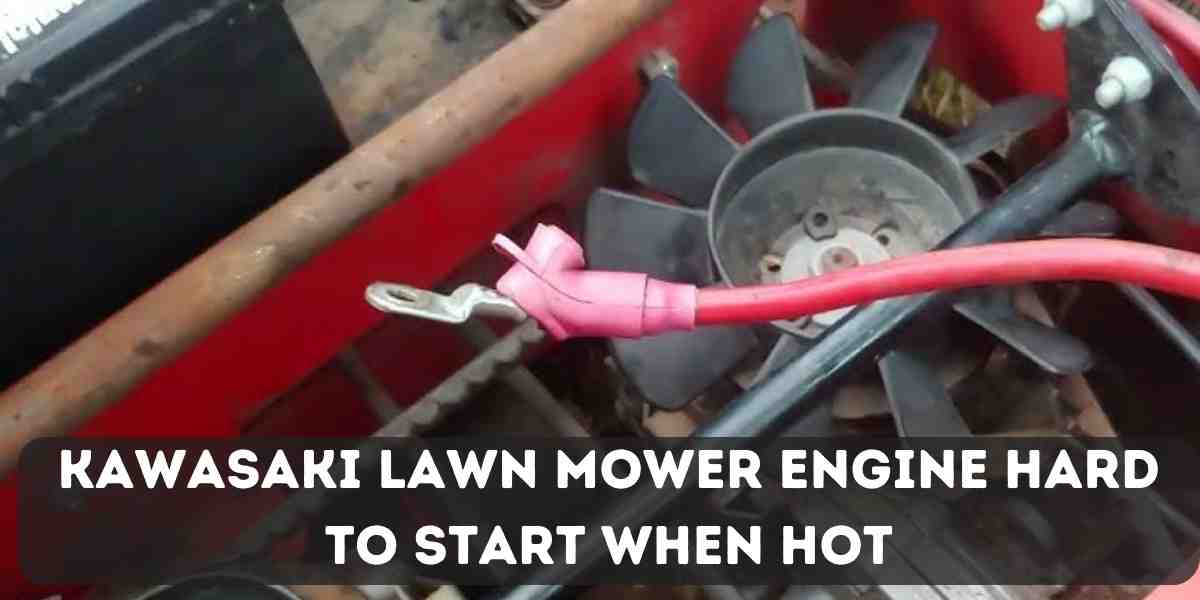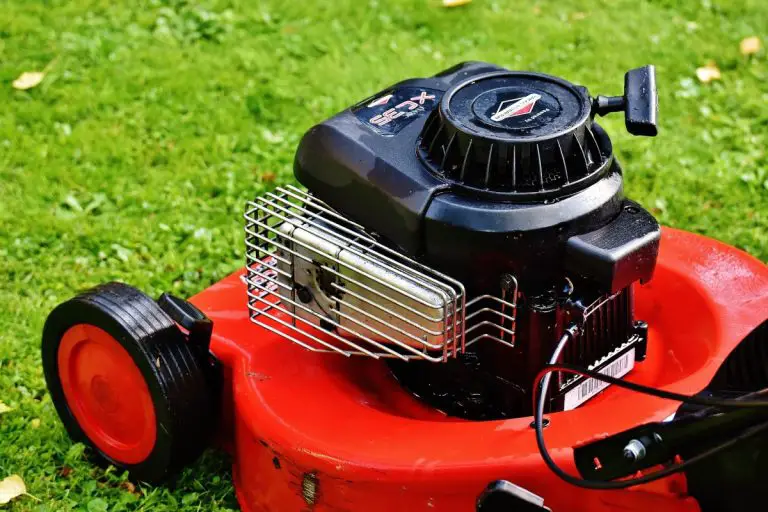Kawasaki Lawn Mower Engine Hard to Start When Hot
Kawasaki lawn mower engines can be difficult to start when hot due to issues with the fuel system or ignition. Here are some possible solutions to address this problem.
Many owners face this common issue, which can be frustrating and time-consuming. A lawn mower that doesn’t start easily not only slows down your yard work but can also be a sign of underlying problems with your equipment.
Understanding the causes behind this difficulty can help you find the right solution and have your lawn mower running smoothly again. We will explore some reasons why a Kawasaki lawn mower engine may be hard to start when hot, along with potential troubleshooting steps to resolve the issue.
Understanding Heat Exhaustion In Kawasaki Lawn Mower Engines
When it comes to maintaining a healthy and efficient lawn mower engine, understanding the concept of heat exhaustion becomes crucial. Heat exhaustion refers to the condition where excessive heat buildup affects the performance of the engine, making it hard to start when hot.
This issue can arise in Kawasaki lawn mower engines when they are subjected to high temperatures for extended periods of time.
In this section, we will explore the symptoms of heat exhaustion in mower engines, the impact of high temperatures on engine performance, and the importance of addressing heat-related issues promptly.
Symptoms of Heat Exhaustion in Mower Engines
The symptoms of heat exhaustion in Kawasaki lawn mower engines are clear indicators that your engine might be suffering from excessive heat buildup.
Recognizing these symptoms can help you diagnose the issue early on and prevent further damage.
Some common symptoms include:
- Engine struggles to start when it is hot
- Decreased power and performance
- Inconsistent or uneven engine operation
- Engine stalling or shutting down unexpectedly
- Increased fuel consumption
Impact of High Temperatures on Engine Performance
High temperatures pose a significant impact on the overall performance of Kawasaki lawn mower engines. When the engine is exposed to excessive heat, several problems can arise, affecting its efficiency and longevity.
The key impacts of high temperatures on engine performance include:
| Impact |
|---|
| 1. Vapor lock |
| 2. Increased wear and tear |
| 3. Reduced engine power |
| 4. Decreased fuel efficiency |
| 5. Risk of engine overheating |
Vapor lock occurs when the fuel in the engine evaporates too quickly, leading to fuel delivery issues and difficulty in starting the engine.
High temperatures also contribute to increased wear and tear on engine components, which can result in premature failure. Additionally, the engine’s power output may decrease, causing a reduction in overall performance.
Furthermore, high temperatures can negatively impact fuel efficiency, leading to increased fuel consumption. If left unaddressed, the engine can even overheat, potentially causing severe damage.
Importance of Addressing Heat-Related Issues Promptly
Addressing heat-related issues promptly is of utmost importance when it comes to ensuring the optimal performance and longevity of your Kawasaki lawn mower engine.
Ignoring or delaying the resolution of these issues can lead to further damage and costly repairs. Promptly addressing heat-related issues brings several benefits, including:
- Improved engine performance and power
- Enhanced fuel efficiency
- Reduced risk of engine overheating
- Extended engine lifespan
By taking immediate action and fixing heat-related problems, you can experience improved engine performance, allowing your lawn mower to operate optimally.
Moreover, addressing these issues promptly can enhance fuel efficiency, saving you money on fuel costs. Additionally, timely resolution reduces the risk of engine overheating, protecting your engine from potential damage.
Common Causes Of Kawasaki Lawn Mower Engine Heat Exhaustion
When it comes to maintaining your Kawasaki lawn mower engine, heat exhaustion can be a frustrating problem. If you find that your engine is hard to start when hot, there are several common causes that may be to blame.
It’s important to understand these causes in order to effectively address the issue and prevent any further damage.
In this section, we will discuss three common causes of Kawasaki lawn mower engine heat exhaustion: inadequate cooling mechanisms, restricted airflow to the engine, and overworked engine components due to prolonged use.
Inadequate cooling mechanisms
One of the main causes of heat exhaustion in a Kawasaki lawn mower engine is inadequate cooling mechanisms. It’s essential for the engine to stay at an optimal temperature to function properly.
If the cooling mechanisms, such as the radiator or the fan, are not working effectively, the engine can quickly overheat. This can lead to difficulties in starting the engine when it is hot.
Inadequate cooling mechanisms can be caused by a variety of issues, such as a malfunctioning thermostat, a clogged radiator, or a faulty fan motor.
It is important to regularly inspect and maintain these cooling components to ensure they are functioning correctly.
Restricted airflow to the engine
Another common cause of heat exhaustion in a Kawasaki lawn mower engine is restricted airflow to the engine. The engine requires a constant flow of fresh air to keep it cool. If there are any obstructions or blockages in air intake or exhaust areas, it can result in limited airflow.
This restricted airflow can cause the engine to overheat and make it harder to start when hot. Common causes of restricted airflow include a dirty air filter, debris buildup in the air intake, or a blocked exhaust system.
Regularly cleaning or replacing the air filter and ensuring that the air intake and exhaust are clear of any obstructions is crucial for maintaining proper airflow to the engine.
Overworked engine components due to prolonged use
Lastly, overworked engine components due to prolonged use can contribute to heat exhaustion in a Kawasaki lawn mower engine.
When the engine is used for extended periods without breaks, it can become strained and overheated. Overworked engine components, such as the piston, valves, or spark plugs, may not function optimally and can cause issues with engine starting.
It is important to allow the engine to cool down periodically during use, especially in hot weather conditions. Additionally, regular maintenance and timely replacement of worn-out engine components can help prevent overworking the engine and reduce the occurrence of heat exhaustion.
By understanding and addressing the common causes of Kawasaki lawn mower engine heat exhaustion, you can keep your engine running smoothly and ensure easy starting even when hot.
Implementing Effective Maintenance Practices To Overcome Heat Exhaustion
When it comes to the issue of a Kawasaki lawn mower engine being hard to start when hot, implementing effective maintenance practices can be the key to overcoming heat exhaustion.
By ensuring regular cleaning and inspection of engine cooling mechanisms, ensuring proper ventilation and airflow around the engine, and monitoring and addressing overheating warning signs in a timely manner, you can prevent the engine from struggling and ensure smooth start-ups even in hot conditions.
Regular cleaning and inspection of engine cooling mechanisms
One of the most important maintenance practices to overcome heat exhaustion in your Kawasaki lawn mower engine is regular cleaning and inspection of the engine cooling mechanisms.
Over time, debris, dirt, and grime can accumulate on the cooling fins and restrict proper airflow, leading to overheating issues. To prevent this, make sure to:
- Clean the cooling fins using a soft brush or compressed air to remove any clogs
- Inspect the cooling fan and make sure it is functioning properly
- Check for any leaks in the cooling system and address them promptly
Ensuring proper ventilation and airflow around the engine
Another important aspect of maintenance is ensuring proper ventilation and airflow around the engine. When the engine is exposed to excessive heat and lacks sufficient airflow, it can lead to hard starts. To promote proper ventilation and airflow, consider the following steps:
- Remove any debris or obstructions around the engine housing
- Make sure the air intake and exhaust vents are clean and unobstructed
- Keep the engine housing and surrounding areas free from grass clippings, leaves, or other materials that can impede airflow
Monitoring and addressing overheating warning signs in a timely manner
Being proactive in monitoring and addressing overheating warning signs is crucial in preventing hard starts when the engine is hot. Pay close attention to the following warning signs and take immediate action if you notice them:
- Increase in engine temperature gauge reading
- Steam or smoke coming from the engine
- Unusual smells or burning odors
- Engine sputtering or stalling
If you experience any of these warning signs, stop the engine immediately and allow it to cool down before inspecting for any issues. Addressing overheating problems promptly can help prevent further damage and ensure a smoother start-up when the engine is hot.
Checking The Cooling System For Blockages And Malfunctions
When it comes to a Kawasaki lawn mower engine that is hard to start when hot, one of the potential culprits could be a malfunctioning cooling system.
Over time, the cooling system of the mower engine may become clogged with debris or experience faulty components, impeding the engine’s ability to cool down properly.
Inspecting the Radiator for Debris Accumulation
The radiator plays a vital role in maintaining the optimal temperature of the lawn mower engine. However, it can become clogged with debris, preventing proper airflow and causing the engine to overheat. To check the radiator for any accumulation of debris, follow these simple steps:
- Start by shutting off the engine and allowing it to cool down completely.
- Locate the radiator, usually positioned near the engine.
- Using a soft brush or compressed air, carefully remove any debris or dirt that may have accumulated on the radiator fins.
- Inspect the radiator for any signs of damage or blockage. If you notice any major damage or blockage, it may be necessary to replace the radiator.
Cleaning or Replacing the Air Filter for Better Airflow
The air filter acts as a barrier, preventing debris and dust from entering the engine. Over time, the air filter can become dirty and clogged, restricting airflow and causing the engine to overheat.
To ensure proper airflow and prevent difficulties in starting your Kawasaki lawn mower engine when hot, follow these steps to clean or replace the air filter:
- Refer to your lawn mower’s manual to locate the air filter assembly.
- Remove the air filter housing carefully.
- If the air filter is made of foam or fabric material, gently wash it using mild soap and water. Allow it to air dry completely before reinstallation.
- If the air filter is disposable or made of paper material, replace it with a new one.
- Reassemble the air filter housing and ensure it is securely in place.
Verifying the Functionality of the Cooling Fan and Thermostat
The cooling fan and thermostat are crucial components of the cooling system that regulate the engine’s temperature.
If either of these components is malfunctioning, it can lead to overheating issues and difficulty in starting the engine when hot.
Here’s how you can verify the functionality of the cooling fan and thermostat:
- Start the engine and allow it to run until it reaches normal operating temperature.
- Observe whether the cooling fan starts automatically. The fan should begin spinning once the engine reaches a certain temperature.
- If the fan doesn’t start or seems to be working improperly, it may indicate a faulty cooling fan motor. Consider consulting a professional technician or the engine manufacturer for further assistance.
- You can also test the thermostat by gently touching the upper radiator hose after the engine has reached operating temperature. If the hose feels cool, it may indicate a malfunctioning thermostat that is not allowing coolant circulation. In such cases, it is recommended to have the thermostat replaced.
By thoroughly inspecting the radiator for debris accumulation, cleaning or replacing the air filter, and verifying the functionality of the cooling fan and thermostat, you can ensure the cooling system of your Kawasaki lawn mower engine is in optimal condition.
Optimizing Engine Performance To Reduce Heat Build-Up
When it comes to keeping your Kawasaki lawn mower engine running smoothly, addressing the issue of hard starts when hot is crucial.
One of the most common causes of this problem is excessive heat build-up within the engine. To ensure optimal performance and prevent overheating, it’s essential to implement a few key strategies.
By using the correct fuel and oil types for your specific mower model, maintaining appropriate oil levels, and adjusting the engine’s air-fuel mixture, you can reduce the risk of your Kawasaki lawn mower engine becoming hard to start when hot.
Using the Correct Fuel and Oil Types for the Specific Mower Model
Choosing the right fuel and oil for your Kawasaki lawn mower engine is essential for keeping it running smoothly, especially when operating in high temperatures. Different engine models require specific fuel and oil types to maintain optimal performance.
Refer to your mower’s owner’s manual or consult with a professional to determine the appropriate fuel-oil ratio and the recommended oil viscosities suitable for your specific model.
Maintaining Appropriate Oil Levels and Changing It Regularly
Proper lubrication is crucial for preventing excessive heat build-up within your engine. To ensure optimal performance, it’s important to maintain appropriate oil levels and change it regularly.
Check the oil level regularly using the dipstick provided on your mower’s engine and top it off as needed.
Additionally, schedule regular oil changes according to your mower’s maintenance schedule or as recommended by the manufacturer. Doing so will help keep the engine cool and reduce the risk of hard starts when hot.
Adjusting the Engine’s Air-Fuel Mixture to Prevent Overheating
The air-fuel mixture plays a significant role in maintaining the right operating temperature for your Kawasaki lawn mower engine.
An incorrect air-fuel ratio can lead to overheating and difficulty starting when hot. Consult your mower’s owner’s manual or seek professional assistance to adjust the carburetor settings, ensuring the air-fuel mixture is within the recommended range.
This adjustment will help prevent excessive heat build-up and ensure your engine starts smoothly, even in hot conditions.
Taking Steps To Minimize Heat Transfer To The Engine
The hot summer months can present a challenge when it comes to starting your Kawasaki lawn mower engine. As temperatures rise, heat transfer to the engine can lead to difficulties in starting the mower.
However, by taking a few simple steps, you can minimize heat transfer and ensure your engine starts effortlessly even in the hottest conditions.
Keeping the mower in shaded areas when not in use
One effective way to minimize heat transfer to the engine is by keeping your mower in shaded areas when it’s not in use.
Direct sunlight can cause excessive heat buildup, making it harder to start the engine. By finding a cool, shaded spot to store your mower, you can prevent the engine from overheating and make starting it a breeze.
Using reflective covers or shields to deflect direct sunlight
In addition to keeping your mower in the shade, using reflective covers or shields can further minimize heat transfer to the engine.
These covers act as a barrier, deflecting direct sunlight and reducing the amount of heat absorbed by the engine.
By investing in a reflective cover or shield, you can protect your mower from excessive heat and make starting easier, even on scorching hot days.
Troubleshooting And Resolving Kawasaki Lawn Mower Engine Starting Issues
Troubleshooting and resolving starting issues with your Kawasaki lawn mower engine can be frustrating, especially when it refuses to start when hot.
However, by identifying potential fuel-related problems, checking the ignition system for faults, and addressing carburetor issues, you can get your lawn mower engine up and running smoothly.
Identifying potential fuel-related problems
When your Kawasaki lawn mower engine is hard to start when hot, it’s crucial to consider potential fuel-related issues as the root cause. Start by checking if there’s enough fuel in the tank. Use the dipstick to measure the fuel level accurately. If it’s low, top off the tank with fresh fuel.
Besides fuel level, inspect the fuel filter for any clogs or debris that may obstruct the fuel flow. Replace the filter if necessary.
Additionally, examine the fuel line for any cracks or leaks that could be affecting the engine’s ability to start smoothly when hot. Address any issues with the fuel system promptly to ensure an optimal starting performance.
Checking the ignition system for faults
If fuel-related problems have been ruled out, it’s time to focus on the ignition system. Begin by examining the spark plug. Remove it from the engine and inspect its condition. A dirty or damaged spark plug can hinder the starting process. Clean or replace the spark plug as needed.
Next, check the spark plug wire for any signs of wear or damage. A faulty wire can disrupt the ignition process and make starting the engine problematic when it’s hot. Replace the wire if necessary. Additionally, ensure that the ignition coil is properly connected and functioning correctly.
Addressing carburetor issues that may affect starting when hot
A carburetor issue can often be the culprit behind starting issues when your Kawasaki lawn mower engine is hot. Inspect the carburetor for any clogs, dirt buildup, or blockages. Use a carburetor cleaner and a small brush to clean the carburetor thoroughly. Pay special attention to the small openings and jets.
In some cases, the carburetor may need to be adjusted to ensure the optimal fuel-air mixture. Consult your owner’s manual or seek professional assistance to adjust the carburetor properly. This will help enhance the engine’s starting performance, especially when hot.
Follow the recommended steps and guidelines in this section to ensure that your lawn mower engine performs reliably and starts effortlessly, even under hot conditions.
Diagnosing And Addressing Fuel-Related Problems
When your Kawasaki lawn mower engine is hard to start when hot, it could be attributed to various factors. One of the most common culprits is fuel-related problems.
By understanding how to diagnose and address these issues, you can ensure your lawn mower starts smoothly every time.
In this section, we will cover three key steps to help you tackle fuel-related problems: verifying fuel quality and freshness, cleaning or replacing the fuel filter, and adjusting the carburetor for optimal fuel delivery.
Verifying fuel quality and freshness
Ensuring your lawn mower is fueled with high-quality and fresh fuel is crucial for optimal engine performance. Over time, gasoline can degrade, leading to poor combustion and difficulty starting the engine.
To verify the fuel quality and freshness:
- Check the color and smell of the fuel. Fresh fuel should have a clear, light amber color and a pleasant odor. If the fuel appears dark or has a foul smell, it may be contaminated or old.
- Inspect the fuel container for signs of rust, corrosion, or debris. These can contaminate the fuel and affect its performance.
- Use a clean container to store fuel. Avoid using dirty or rusty containers that may introduce impurities into the fuel.
- Consider using a fuel stabilizer if you plan to store fuel for an extended period. This can help maintain its quality.
Cleaning or replacing the fuel filter to ensure proper fuel flow
The fuel filter plays a crucial role in preventing debris and impurities from reaching the engine. A clogged or dirty fuel filter can restrict fuel flow, causing starting issues.
To clean or replace the fuel filter:
- Locate the fuel filter, typically found along the fuel line between the fuel tank and the carburetor.
- Inspect the filter for any signs of clogs, dirt, or damage. If the filter is dirty or damaged, it is recommended to replace it.
- To clean the filter, remove it from the fuel line and rinse it with clean gasoline. Ensure all debris is removed.
- If replacing the filter, follow the manufacturer’s instructions for installation. Make sure to use a compatible and high-quality replacement filter.
Adjusting the carburetor for optimal fuel delivery
The carburetor is responsible for mixing air and fuel in the correct ratio for combustion. If the carburetor is improperly adjusted, it can lead to too little or too much fuel entering the engine, making it difficult to start. To adjust the carburetor:
- Locate the carburetor on your Kawasaki lawn mower engine.
- Refer to the engine’s manual or Kawasaki’s official website for the recommended carburetor adjustment specifications.
- Use a small flathead screwdriver to access the carburetor adjustment screws.
- Follow the provided instructions to adjust the screws to the recommended settings. Start with small adjustments and test the engine’s starting performance after each adjustment.
- Ensure the air filter is clean and properly installed, as a dirty or clogged air filter can also affect fuel delivery.
By following these steps and addressing any fuel-related problems, you can increase the chances of your Kawasaki lawn mower engine starting easily, even when hot.
Regular maintenance and proper fuel management will help keep your lawn mower running smoothly, allowing you to enjoy a well-maintained lawn without the frustrations of a hard-to-start engine.
Inspecting The Ignition System For Faults
One common issue that Kawasaki lawn mower owners might face is a hard-to-start engine when it’s hot. This can be frustrating and inconvenient, especially if you need to continue mowing your lawn.
The ignition system plays a vital role in starting the engine, and any faults within this system can contribute to the difficulty in starting the mower.
Here, we will guide you through inspecting the ignition system components and identifying potential faults that may be causing the problem.
Checking spark plug connections and condition
The spark plug is an integral part of the ignition system, as it creates the spark needed to ignite the fuel mixture. If the spark plug connections are loose or damaged, it can lead to poor or no spark production. To inspect the spark plug connections:
- Disconnect the spark plug wire by gently pulling it off the spark plug.
- Inspect the spark plug connection for any signs of dirt, corrosion, or damage.
- If you notice any build-up or damage, clean the connection using a wire brush or replace the spark plug if necessary.
- Reconnect the spark plug wire firmly onto the spark plug, ensuring a secure connection.
Regularly inspecting and maintaining the spark plug connections can help ensure a reliable spark and improve the starting process when your lawn mower is hot.
Testing the ignition coil for proper function
The ignition coil is responsible for amplifying the voltage from the battery to create the spark that ignites the fuel mixture. A faulty ignition coil can result in weak or no spark production, making the engine hard to start. To test the ignition coil:
- Disconnect the spark plug wire from the spark plug.
- Remove the ignition coil from the engine as per the manufacturer’s instructions.
- Check the resistance of the ignition coil using a multimeter. Refer to the user manual for the specific resistance values depending on your model.
- If the resistance does not align with the recommended values, consider replacing the ignition coil.
- Reinstall the ignition coil onto the engine, ensuring proper connection.
Testing the ignition coil can help identify if it’s the culprit behind the difficulty in starting the mower when it’s hot.
Ensuring the flywheel and key are not damaged or misaligned
The flywheel and key work in conjunction to generate the correct timing for spark production. If the flywheel or key is damaged or misaligned, it can disrupt the ignition process and result in starting issues. Here’s how you can check them:
- Locate the flywheel and key, typically located on top of the engine.
- Inspect the flywheel for any signs of damage, such as cracks or missing teeth on the gear.
- Ensure the key is intact and not sheared or broken.
- If you notice any damage or misalignment, consult a professional technician for further inspection and potential repair.
Keeping the flywheel and key in good condition is crucial for smooth ignition and starting, especially when the engine is hot.
Resolving Carburetor Issues Affecting Hot Starting
Having trouble starting your Kawasaki lawn mower engine when it’s hot? One common culprit behind this frustrating issue is carburetor problems.
The carburetor plays a critical role in the engine’s fuel mixture, and when it becomes clogged, dirty, or improperly adjusted, it can cause difficulty in hot starting. In this section, we will explore three essential steps to resolve carburetor issues for improved hot starting performance.
Cleaning or Rebuilding the Carburetor to Remove Clogs or Deposits
One of the main reasons why a Kawasaki lawn mower engine may be hard to start when hot is due to clogs or deposits in the carburetor.
Over time, dirt, debris, and fuel deposits can obstruct the small passages and jets within the carburetor, affecting fuel flow and causing erratic starting behavior.
To remedy this issue, it is crucial to clean or rebuild the carburetor. Cleaning can be done by disassembling the carburetor and using an appropriate carburetor cleaner to remove any clogs or deposits. If the problem persists or if the carburetor is severely damaged, rebuilding the carburetor might be necessary.
During the rebuilding process, damaged or worn-out parts are replaced, ensuring optimal performance and hot starting reliability.
Inspecting the Carburetor Gaskets for Leaks and Replacing if Necessary
Leaky carburetor gaskets can significantly impact hot starting performance. Over time, gaskets can deteriorate, become brittle, or develop cracks, allowing air or fuel to escape, leading to a disrupted fuel mixture.
Regularly inspecting the carburetor gaskets is essential. If any signs of damage or leaking are present, it is crucial to replace the gaskets promptly. Kawasaki lawn mower engines often have specific gasket kits available for purchase, ensuring a proper fit and reliable hot starting performance.
Preventive Measures For Maintaining A Healthy Kawasaki Lawn Mower Engine
Regular engine tune-ups and maintenance, adhering to manufacturer’s recommended service intervals, and proper cleaning and lubrication of engine components are essential for ensuring the longevity and optimal performance of your Kawasaki lawn mower engine.
By following these preventive measures, you can keep your engine running smoothly and avoid the frustration of a hard-starting engine, particularly when it’s hot.
Regular Engine Tune-ups and Maintenance
Regular engine tune-ups play a vital role in keeping your Kawasaki lawn mower engine in peak condition. It involves inspecting and servicing various components to ensure they are working correctly. Here are a few key maintenance tasks to perform:
- Inspect and clean the air filter: The air filter prevents dirt and debris from entering the engine, but over time, it can become clogged, affecting airflow. Regularly check the air filter and clean or replace it as necessary.
- Check and adjust the spark plug: The spark plug ignites the fuel mixture in the engine. A worn-out or improperly gapped spark plug can lead to hard starting. Check the spark plug regularly and replace it if needed.
In addition to these tasks, it’s also important to check the fuel level, oil level and condition, and ensure the engine cooling fins and fuel lines are clean and free from blockages.
Cleaning and Lubricating Engine Components as Needed
Proper cleaning and lubrication of engine components are essential for maintaining performance and reducing wear and tear. Here are a few key points to consider:
- Clean the engine regularly: Grass clippings, dirt, and debris can accumulate in and around the engine, affecting its performance. Regularly clean the engine exterior using a soft brush or compressed air.
- Lubricate moving parts: Your Kawasaki lawn mower engine has various moving parts that require lubrication. Refer to the manufacturer’s recommendations for lubrication points and use the appropriate lubricants.
Frequently Asked Questions
Why Does My Kawasaki Lawn Mower Engine Have Trouble Starting When It's Hot?
When a Kawasaki lawn mower engine is hot, it can be difficult to start due to a few reasons. One possible cause is vapor lock, where the fuel evaporates too quickly, leaving behind air pockets. Another possibility is a faulty ignition coil that struggles to produce a spark when the engine is hot.
Finally, inadequate cooling can cause the engine to overheat, leading to starting issues. It is recommended to check these potential causes if your Kawasaki lawn mower engine is hard to start when it’s hot.
How Can I Prevent My Kawasaki Lawn Mower Engine From Experiencing Starting Problems When It's Hot?
To prevent starting issues with your Kawasaki lawn mower engine when it’s hot, there are a few steps you can take. First, ensure proper cooling by cleaning the cooling fins and ensuring the air flow is not obstructed. Secondly, make sure the fuel system is clean, and the fuel filter is not clogged, which can cause vapor lock.
Finally, regular maintenance, including oil changes and spark plug replacements, can help prevent starting problems.
What Are Some Tips To Make Starting A Hot Kawasaki Lawn Mower Engine Easier?
If you’re having trouble starting your Kawasaki lawn mower engine when it’s hot, here are a couple of tips to make the process easier. First, let the engine cool down for a few minutes before attempting to start it. This allows the fuel to settle and air pockets to dissipate.
Additionally, try priming the carburetor by pushing the primer bulb a few times to inject fuel directly into the engine. These tips can help make starting a hot engine a bit easier.
Final Thought
Dealing with a Kawasaki lawn mower engine that is hard to start when hot can be frustrating. However, by following the troubleshooting steps outlined in this blog post, you can diagnose and resolve the issue effectively. Remember to check the air filter, fuel system, spark plug, and ignition system for any potential problems.
Regular maintenance and proper care will ensure that your lawn mower starts smoothly every time, allowing you to maintain your lawn effortlessly.
Read More:






